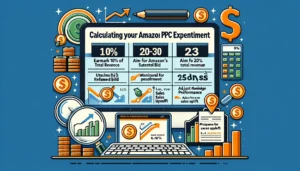How much should my PPC budget be? Determining Your Ideal PPC Budget

Navigating the realm of pay-per-click (PPC) advertising can be daunting, especially when it comes to budgeting. The right PPC budget can make a significant difference in your campaign’s success, but determining that amount is not a one-size-fits-all process. It involves understanding your competitors, selecting the right keywords, optimising for return on ad spend, and balancing ad types. In this article, we’ll delve into the essential steps and strategies to help you pinpoint your ideal PPC budget, whether you’re using Google Ads, Amazon PPC, or any other PPC platform.
Key Takeaways
- Establish a realistic PPC budget by evaluating competitor spending and keyword costs, aiming for a balance between affordability and competitive presence.
- Optimise your PPC campaigns by focusing on return on ad spend (ROAS) and adjust your budget in accordance with revenue growth to maintain profitability.
- Understand the factors that influence Google Ads pricing, and learn to navigate budget allocation to maximise the effectiveness of your campaigns.
- For Amazon PPC, start with a budget of around 10% of total revenue, and allocate spending across different ad types to enhance brand exposure and sales.
- Regularly review and adjust your PPC strategy to ensure it aligns with retail objectives, creating high-quality ads and landing pages for better performance and cost control.
How much should my PPC budget be? Establishing Your PPC Budget Framework
Understanding the Role of Competitors and Keywords
In the realm of PPC, your competitors are both your benchmark and your treasure trove of strategic insights. Conducting a thorough competitor analysis is crucial, as it reveals the keywords they’re targeting, the budget they’re allocating, and the effectiveness of their ad copy. This intelligence allows you to craft a PPC strategy that not only competes but also capitalizes on gaps they may have left open.
Keywords are the linchpin of your PPC campaigns, triggering when and where your ads are displayed. It’s essential to invest time in developing a robust keyword list that encompasses both broad and niche terms pertinent to your products or services. Consider the following when building your keyword strategy:
- Broad match keywords for maximum reach
- Phrase match for targeting specific queries
- Exact match for high-intent traffic
- Negative keywords to exclude irrelevant traffic
Remember, the right mix of keywords can significantly enhance your ad’s visibility and click-through rate, leading to a more cost-effective campaign.
By analysing your competitors’ strategies and refining your keyword selection, you position your campaigns for success. This dual approach ensures you’re not just following the market trends but setting them, by identifying opportunities they’ve overlooked and tailoring your message to meet the real needs of your audience.
How much should my PPC budget be? Setting Realistic Budget Limits
When venturing into the realm of PPC, it’s crucial to anchor your aspirations with a realistic budget. Establishing spending limits is not just about capping costs; it’s about optimising your investment to ensure maximum impact. Start by defining a daily average budget that reflects your ‘comfortable’ spend, allowing platforms like Google Ads to adjust your expenditure based on traffic fluctuations, without exceeding your monthly financial threshold.
Spending limits act as a safeguard, ensuring that your PPC campaigns remain within your financial comfort zone. Remember, the goal is to prevent overspending while still capturing valuable web traffic and conversions. Your bidding strategy plays a pivotal role here, determining how much you’re willing to pay per click, influenced by ad quality and competition. Choose from strategies aimed at maximizing clicks, conversions, or impression share, but always align them with your budgetary constraints.
As you gain insights from performance data, revisit and refine your budget. Adjustments to campaign elements like keywords, match types, ad copy, and landing pages are part of a dynamic process that can lead to more efficient spending and improved outcomes.
Consider the following table to guide your initial budget setting:
| Campaign Element | Consideration |
|---|---|
| Keywords | Competitor analysis and keyword value |
| Match Types | Balance between reach and relevance |
| Ad Copy | Clarity and call-to-action effectiveness |
| Landing Pages | Conversion rate optimisation |
By taking a measured approach to your PPC budget, you can create a sustainable strategy that not only aligns with your business objectives but also adapts to the ever-changing digital landscape.
Adjusting Budgets in Line with Revenue Growth
As your business flourishes, your PPC budget should evolve in tandem. Start by setting a baseline budget that aligns with your current revenue, ensuring it’s neither too restrictive nor excessively ambitious. This initial budget serves as a foundation for future adjustments.
Consider implementing a dynamic budgeting approach, where a percentage of your revenue is earmarked for PPC spending. This method allows for organic growth in your advertising efforts as your sales increase. For example, you might allocate 5% of monthly revenue to PPC, which naturally scales with your financial success.
When you notice a consistent uptrend in revenue, it’s time to reassess your PPC budget. This isn’t just about increasing spend; it’s about optimising for efficiency and seizing opportunities.
Remember, the goal is to maintain a balance between aggressive growth and sustainable investment. If your campaigns are already performing well, reinvesting a portion of the profits can amplify success. However, if you’re not seeing the desired ROI, it’s crucial to analyze and adjust your campaigns before scaling up.
Here’s a simple framework to guide your budget adjustments:
- Review your current ROI and set a target for improvement.
- Calculate the additional budget needed to hit your new targets.
- Monitor closely and tweak campaigns to ensure continued profitability.
By following these steps, you’ll ensure that your PPC budget is a driving force behind your business growth, rather than a static figure.
How much should my PPC budget be? Key Elements of a Successful PPC Campaign
Determining Campaign Budgets
When you’re ready to set your PPC campaign budget, start by asking yourself what you aim to achieve. Is it brand awareness, lead generation, or direct sales? Your goals will dictate the scale and allocation of your budget. Establish a clear relationship between your campaign objectives and your budget to ensure that every dollar spent is a step towards your business targets.
- Set your Goals and Budget: Begin by defining the outcomes you desire from your campaign. Then, determine a financial threshold that aligns with your business’s marketing strategy and financial health.
- Find the Right Keywords: Utilise tools like Google Keyword Planner or Semrush to discover keywords that resonate with your audience’s search behavior.
- Monitor and Adjust: Implement constraints to prevent overspending, and be prepared to revisit and refine your budget as you analyse performance data.
Remember, a well-defined PPC budget is not static. It’s a dynamic component that should evolve with your campaign’s performance and business growth. Regularly assess the effectiveness of your budget in relation to the results it’s generating, and don’t hesitate to make adjustments. This proactive approach will help you maintain a competitive edge and optimise your return on investment.
How much should my PPC budget be? Optimising for Return on Ad Spend (ROAS)
To truly harness the power of your PPC campaigns, you must optimise for Return on Ad Spend (ROAS). This metric is pivotal in ensuring that every dollar you invest works as hard as possible towards your business goals. Start by analysing the performance bottlenecks in your campaigns, such as gaps in exposure, ad clicks, or landing page conversions.
By pinpointing these areas, you can tailor your strategies to overcome the hurdles and enhance your ROAS.
Experiment with different bidding strategies, like manual CPC for high-value branded keywords, or automated options such as target CPA and maximise conversions. It’s crucial to evaluate the outcomes of these strategies regularly, adjusting your approach based on the data-driven insights you gather.
Remember, PPC ads offer a cost-effective way to reach your audience since you only pay for actual clicks. To maintain control over your costs and ensure profitability, set daily and monthly spending caps that align with your expected sales revenue or profit margin. For instance, if your product averages USD$100 and you aim for a 50% margin, your campaigns should aim for an ROAS exceeding 2X.
Balancing Ad Spend Across Campaign Types
When you’re juggling multiple PPC campaigns, it’s crucial to strike the right balance in your ad spend. Diversification is key; not all campaigns will perform equally, but each serves a unique purpose in your overall strategy. Start by categorising your campaigns based on objectives such as brand awareness, lead generation, or direct sales.
Consider the following points to guide your allocation:
- Brand awareness campaigns may have a lower direct ROI but are essential for long-term growth.
- Lead generation campaigns should be optimised for cost-per-lead and conversion rates.
- Direct sales campaigns require close monitoring of ROAS to ensure profitability.
Remember, the goal is not to allocate your budget evenly, but effectively. Each campaign type should be funded based on its role in your sales funnel and its past performance data.
Lastly, don’t forget to A/B test your ads within each campaign type. This allows you to refine your approach and ensure that your budget is being spent on the most effective ads. Regularly revisiting and adjusting your budget allocation is not just recommended, it’s a necessity for staying competitive and maximising your PPC’s potential.
How much should my PPC budget be? Decoding Google Ads Budgeting
Factors Influencing Google Ads Costs
When you’re navigating the complex world of Google Ads, understanding the factors that influence cost is crucial. Keyword competitiveness is a primary driver; the more businesses vying for the same keywords, the higher the cost per click (CPC). Ad quality, too, plays a significant role. Google rewards well-crafted ads with a higher Quality Score, which can lead to lower costs and better ad placement.
- Keyword Competitiveness
- Ad Quality
- Campaign Complexity
- Targeting Specifics
- Account Size and Age
The complexity of your campaign and the specifics of your targeting strategy, such as location and demographics, also affect pricing. If you’re targeting a high-income demographic in a competitive location, expect to pay a premium. Additionally, the size and age of your Google Ads account can influence costs; established accounts with a history of good performance may benefit from lower CPCs.
Remember, aligning with experienced Google ads agencies or Google advertising agencies can provide you with the expertise needed to optimise these factors for cost-efficiency.
Current trends in your sector can cause fluctuations in ad pricing. For instance, advertising seasonal products will be more cost-effective during off-peak times. It’s essential to stay informed and adapt your strategy accordingly. Partnering with Google advertising agencies that specialise in Google Ads and PPC services can be a strategic move to manage these variables effectively.
How much should my PPC budget be? Navigating Budget Allocation within Google Ads
When you’re steering the ship of your Google Ads campaigns, think of your budget as the compass guiding you through the vast sea of online advertising. Your daily budget is the cornerstone of cost control, allowing you to set a comfortable spend level that Google Ads will average out over a month. This means on days with less traffic, you’ll spend less, and on busier days, you might spend a bit more, but never exceeding your set daily budget times the average number of days in a month.
To navigate these waters effectively, you’ll need to balance your maximum bids with the constraints of your budget. This balance ensures you’re not overspending while still capturing valuable web traffic and sales. As you gather performance data, it’s crucial to regularly revisit and adjust your budget. Consider tweaking campaign elements like keywords, match types, ad copy, and landing pages to optimise your spend.
Remember, the position of your ad in the auction, and consequently in the Search Engine Results Page (SERP), can be significantly influenced by how well you manage your budget alongside other campaign elements.
Here’s a simple list to keep in mind for budget allocation within Google Ads:
- Define a daily average budget that aligns with your monthly advertising goals.
- Monitor your spending closely, especially on high-traffic days.
- Adjust bids and budgets based on campaign performance and data insights.
- Regularly review and refine your campaign elements to enhance ad placement and performance.
Analysing Cost Breakdown for Sample Campaigns
Diving into the cost breakdown of sample campaigns can illuminate the path to a more efficient PPC strategy. Start by conducting a thorough Google ads audit; this will help you identify areas where your budget may be leaking and opportunities for optimisation. Key metrics to scrutinise include cost per click (CPC), click-through rate (CTR), and conversion rates.
Consider the following table as a simplified example of how to analyse a campaign’s cost efficiency:
| Metric | Before Optimisation | After Optimisation |
|---|---|---|
| CPC | $2.50 | $2.00 |
| CTR | 1.5% | 2.0% |
| Conversions | 100 | 120 |
By comparing these metrics before and after changes, you can gauge the impact of your adjustments. Remember, a successful PPC campaign is not just about reducing costs, but also about enhancing the value you get from each dollar spent.
When adjusting your PPC budgets, always align your spending with the insights gathered from performance data. This ensures that your investment is continually refined to capture the most valuable web traffic and conversions.
Regularly revisit your budget as you gather performance data, tweaking campaign elements like keywords, match types, ad copy, and landing pages to prevent overspending while still capturing valuable traffic and sales.
How much should my PPC budget be? Effective Amazon PPC Spending Strategies
Calculating Your Amazon PPC Expenditure
To navigate the complexities of Amazon PPC expenditure, start by earmarking approximately 10% of your total revenue for your PPC budget. This figure is a foundational benchmark that aligns your advertising spend with your sales performance, ensuring a symbiotic growth relationship between the two.
Optimisation is key; initially, aim for a daily spend that garners 20-30 clicks, providing a substantial data set for performance analysis. Utilise Amazon’s suggested bid feature to gauge competitive bids and refine your budget accordingly.
Remember, a strategic Amazon PPC investment is not just a short-term boost but a lever for long-term organic growth and increased sales.
Adjust your budget in response to the insights gleaned from Amazon’s advertising reports. A well-managed PPC campaign can contribute to a 25% uplift in total sales, though this will vary based on product type, margins, and ROI. Regularly review the ‘almost or out of budget’ filter to ensure your campaigns are fully capitalised and not prematurely capped.
Here’s a simple framework to consider when calculating your Amazon PPC expenditure:
- Establish a baseline budget of 10% of total revenue.
- Set a daily spend for a minimum of 20-30 clicks.
- Use Amazon’s suggested bid feature for competitive insights.
- Monitor advertising reports for performance impact.
- Adjust budgets to maintain a 25% sales uplift target.
How much should my PPC budget be? Maximising ROI with Cost-Effective PPC Ads
To truly maximise ROI with cost-effective PPC ads, you must refine your approach to Google ads PPC, Google Adwords PPC, and eCommerce PPC. Crafting ads that resonate with your target audience while also being budget-friendly is key. Start by analysing the data: conversion rates, click-through rates, and average cost per click are your guiding stars.
By meticulously adjusting bids and targeting, you can enhance ad performance without inflating costs. This strategic maneuvering ensures your campaigns remain profitable and sustainable over time.
Consider the following elements to optimise your PPC ads for maximum ROI:
- Keyword Selection: Choose keywords with a high intent to purchase but lower competition to reduce costs.
- Ad Copy Excellence: Create compelling ad copy that stands out and encourages clicks.
- Landing Page Optimisation: Ensure your landing page is relevant and converts visitors effectively.
- Bid Management: Regularly review and adjust your bids to stay competitive without overspending.
Remember, the goal is not just to attract clicks, but to convert those clicks into customers. Keeping a close eye on your campaign metrics and making data-driven decisions will help you maintain a cost-effective strategy that drives sales.
Maintaining Budget Control and Performance Monitoring
In the realm of PPC management, maintaining a tight grip on your budget while ensuring optimal performance is paramount. Set clear spending limits to prevent your costs from spiraling out of control; these act as a safeguard, keeping your expenditure within the bounds of your financial strategy.
Your bidding strategy is the rudder that steers your PPC ship. It determines how much you’re willing to pay per click, influencing not only your ad placement but also the overall effectiveness of your campaign. Choose wisely from the array of bidding strategies to meet your specific goals, whether that’s maximising clicks, conversions, or impression share.
Keep a vigilant eye on your campaign’s performance. Regular check-ins are crucial to ensure that your PPC efforts are in sync with your marketing objectives and that your budget is being used effectively.
Remember, PPC advertising is dynamic, and factors beyond your control may impact your performance. Stay adaptable, and be prepared to adjust your strategies as needed. Here’s a quick checklist to help you stay on track:
- Review your budget constraints regularly to avoid overspending.
- Adjust bids for keywords and pause or resume campaigns as necessary.
- Analyse your Quality Score and optimise ads and landing pages to improve it.
- Monitor analytics and reporting closely to measure results and make data-driven decisions.
How much should my PPC budget be? Crafting a PPC Strategy for Retail Success
Aligning PPC with Retail Objectives
To ensure your PPC efforts are not just a shot in the dark, aligning them with your retail objectives is crucial. Start by setting clear, measurable goals that are directly tied to your business outcomes. Whether it’s increasing online sales by 20% or driving more foot traffic to your brick-and-mortar locations, your PPC campaigns should be a lever to achieve these targets.
Your PPC strategy should be a reflection of your retail brand’s unique value proposition. Tailor your ads to highlight what sets you apart from competitors, whether it’s exclusive products, superior customer service, or a niche market focus. This alignment ensures that every click has the potential to convert a shopper who resonates with your brand’s ethos.
By meticulously selecting keywords and crafting ad copy that echoes your retail objectives, you’re not just bidding for visibility—you’re investing in a targeted approach that speaks directly to your desired audience.
Remember, PPC is not a static entity; it requires ongoing optimisation. Regularly review your campaigns against your retail objectives, adjusting bids, ad copy, and targeting to continuously refine your strategy. Here’s a simple checklist to keep your PPC aligned:
- Define clear and measurable retail objectives
- Identify your unique value proposition
- Select keywords that reflect your brand and objectives
- Craft compelling ad copy that speaks to your target audience
- Continuously review and adjust your campaigns
How much should my PPC budget be? Creating High-Quality Ads and Landing Pages
In the realm of PPC, the quality of your ads and landing pages is paramount. Engaging with a PPC agency can significantly enhance the effectiveness of your campaigns. Boldly crafted ad copy and meticulously designed landing pages are the cornerstones of conversion success.
When considering a London PPC agency, look for one that offers unique landing page designs tailored to your brand and products. A PPC ad agency that provides custom ad copy will ensure your message resonates with your target audience. Here’s a quick checklist to guide you:
- Collaborate with a PPC eCommerce agency for specialised expertise.
- Insist on A/B testing to refine landing page performance.
- Demand captivating content and clear calls-to-action (CTAs).
Remember, the goal is not just to attract clicks, but to convert those clicks into customers. Your landing pages should be as compelling as your ads, guiding visitors towards making a purchase or taking the desired action.
Finally, don’t settle for sending potential customers to a generic homepage. Each ad should lead to a dedicated landing page that aligns with the specific campaign’s message and goals. This strategic approach will help maximise your PPC investment and drive meaningful results.
Regularly Reviewing and Adjusting PPC Tactics
In the dynamic landscape of PPC, regular reviews and adjustments are not just recommended; they’re essential for sustained success. Begin with a comprehensive PPC audit to evaluate the effectiveness of your campaigns. This audit should encompass a thorough analysis of ad segments, campaign settings, and bidding methods. Adjust your bids based on insights about your customers’ activities to optimise your campaigns for better performance.
Consider the following steps to ensure your PPC strategy remains robust and responsive:
- Revisit your campaign structure to verify proper ad group segmentation.
- Examine the ‘almost or out of budget filter’ to assess if campaigns are utilising the daily budget effectively.
- Analyse advertising reports in conjunction with business reports to gauge the impact of PPC on total sales.
Remember, PPC campaigns are malleable. Don’t hesitate to reshape your approach by experimenting with new keywords, targeting adjustments, and creative content. The goal is to find the combination that yields the highest ROI for your retail objectives.
By staying vigilant and proactive, you can maintain a PPC strategy that not only meets but exceeds the evolving demands of the digital marketplace.
How much should my PPC budget be? Conclusion: Balancing Spend and Strategy in PPC
Determining the ideal PPC budget is a nuanced process that requires a balance between strategic planning and financial prudence. As we’ve explored, setting a realistic budget involves understanding your market, considering the cost-per-click in your industry, and aligning your spending with your business goals and expected ROI. Remember, PPC is not a one-size-fits-all endeavor; it’s a marathon that demands continuous optimisation and a keen eye on performance metrics. Whether you’re allocating 10% of your revenue to Amazon PPC or crafting a Google Ads strategy, the key is to focus on creating high-quality ads and landing pages to maximise your Quality Score and ROI. By doing so, you’ll ensure that every dollar spent is an investment towards achieving your marketing objectives and growing your business.
Frequently Asked Questions
How do I establish a realistic PPC budget?
First, consider your competitors and the keywords you want to target. Set a budget that reflects the expected click volume, cost-per-click in your industry, and conversion rates. It’s vital to balance the potential return on ad spend (ROAS) with a budget that prevents overspending.
What percentage of my revenue should I allocate to Amazon PPC?
It’s recommended to start with around 10% of your total revenue for Amazon PPC. As your sales grow, you can adjust this budget to feed into new or existing campaigns.
What are the essential components of a well-optimised PPC campaign?
A well-optimised PPC campaign should have a clear budget, target the right keywords, have high-quality ads and landing pages, and be regularly reviewed for performance. It should also focus on maximising the ROAS while maintaining cost control.
How does budgeting work within Google Ads?
Google Ads allows you to set daily or monthly budgets for your campaigns. Costs are influenced by factors like click volume, industry CPCs, and Quality Score. Regular analysis of cost-per-conversion and other metrics is essential for effective budgeting.
How can I ensure my PPC ads are cost-effective?
To ensure cost-effectiveness, only pay for actual clicks, not exposure. Set daily and monthly spending caps based on potential revenue or profit margin and aim for campaigns with a ROAS that meets your business goals.
How often should I review and adjust my PPC strategy?
Regularly review your PPC strategy to ensure it aligns with your marketing objectives. Adjustments may be needed to respond to performance data, market changes, or shifts in your business goals. Consistent monitoring helps optimise your ad spend and maintain budget control.
Author
Search Blog
Free PPC Audit
Subscribe to our Newsletter
The Voices of Our Success: Your Words, Our Pride
Don't just take our word for it. With over 100+ five-star reviews, we let our work-and our satisfied clients-speak for us.
"We have been working with PPC Geeks for around 6 months and have found Mark and the team to be very impressive. Having worked with a few companies in this and similar sectors, I rate PPC Geeks as the strongest I have come across. They have taken time to understand our business, our market and competitors and supported us to devise a strategy to generate business. I value the expertise Mark and his team provide and trust them to make the best recommendations for the long-term."
~ Just Go, Alasdair Anderson




